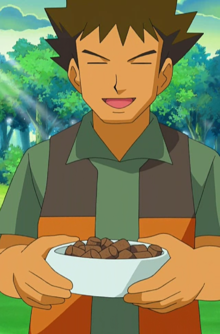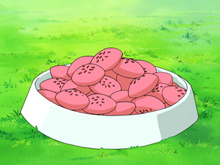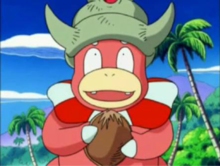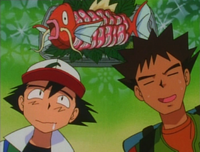Pokémon food
- This article is about the food that Pokémon consume. For Pokémon food products in the real world, see Pokémon food products. For food in the Mystery Dungeon series, see Food (Mystery Dungeon).
Pokémon food is a broad term used for almost any food a Pokémon eats. Despite the variety of both Pokémon and Pokémon food, nearly every Pokémon will eat any kind of Pokémon food. This may mean that the majority of Pokémon are omnivorous. Several species are even capable of consuming things not normally viewed as edible from a human perspective, such as minerals, electrical energy or even abstract concepts such as dreams and emotions. Some species have been said to eat other Pokémon, or be eaten by Pokémon and humans alike, forming a food chain.
In the games
In the core series
Bait
Introduced in the Generation I games and used in Safari Zones, this food will make a wild Pokémon less likely to run away but more difficult to catch. An unlimited supply of Bait is provided for use in the Safari Zone.
Drinks
- Main article: Drink
Introduced in the Generation I games, drinks can be bought from vending machines and can be used to heal Pokémon in much the same way that Potions can at a fraction of the price.
Berries
- Main article: Berry
Introduced in the Generation II games, Berries are a type of item which, unlike Potions or Vitamins, are portrayed as food rather than medicine. A Pokémon may hold this item and, if needed, eat it during a battle to heal itself or cause other effects. In Generation III onwards, these can be planted and harvested by the player. These Berries have names and designs based on real fruits and vegetables.
Pokéblock
- Main article: Pokéblock
Featured in the Hoenn-based Generation III games and their remakes, Pokéblocks are a type of candy which are blended from Berries and given to a Pokémon to raise its condition in several areas. The flavor, level, and feel of the Pokéblock is determined by the ingredients which compose it and how well it is blended.
A Pokémon can only eat a certain number of Pokéblocks before it is full and cannot eat any more. A Pokéblock with lower feel will fill up the Pokémon less than one with greater feel.
In Ruby, Sapphire, and Emerald, Pokéblocks can also be put on a feeder in the Safari Zone to lure wild Pokémon out. After being there for a while, however, the Pokéblock will eventually be eaten. It can also be used in encounters in the Safari Zone in the same manner as bait.
Poffin
- Main article: Poffin
Featured in the Sinnoh-based Generation IV games, Poffins are similar to Pokéblocks. A Poffin will raise the condition of a Pokémon in at least one of five categories: Smart, Cute, Tough, Beauty, and Cool. The flavor and feel of a Poffin is still taken into account just as in a Pokéblock. The main difference is that Poffins are pastries and Pokéblocks are candy. In the anime, Dawn often bakes Poffins for her Pokémon.
Honey
- Main article: Honey
Featured in Generation IV, Honey can be slathered onto a Honey Tree to attract wild Pokémon. It can be placed in a specific location and will disappear (presumably eaten) after some time, and a Pokémon may be found on that tree if checked soon enough. If used in tall grass, it has the same effect as the move Sweet Scent. In the anime, Barry used this method to catch his Heracross.
Aprijuice
- Main article: Apriblender
Apricorns were introduced in Generation II, where their sole use was to create custom Poké Balls. In the remakes of the Generation II games, Pokémon HeartGold and SoulSilver, Apricorns can be blended into drinks called Aprijuice. These drinks will raise a Pokémon's Pokéathlon stats: Speed, Power, Skill, Stamina, and Jump.
Poké Puffs
- Main article: Poké Puff
Featured in Generation VI, Poké Puffs are small cake-like confections that can be fed to Pokémon to increase their Affection. Poké Puffs are obtained by beating minigames or received from visiting Pokémon. They come in the following flavors: Citrus, Mocha, Spice, Mint, and Sweet. In the anime, Serena often bakes Poké Puffs for the group's Pokémon.
Poké Beans
- Main article: Poké Bean
Featured in Generation VII, Poké Beans are similar to Poké Puffs in that they are used to increase a Pokémon's Affection. They can be collected on Isle Abeens and they are also obtained along with the first drink the player orders daily at Pokémon Center Cafés. They come in three different types: Plain, Patterned, and Rainbow.
Other items
A few items that appear to be made for human consumption are supposed to be given to Pokémon to heal them. These items are normally found or sold in certain locations and are considered specialties of those places. These items include the Rage Candy Bar of the Lake of Rage, the Lava Cookie of Lavaridge Town, the Old Gateau of the Old Chateau, the Casteliacone of Castelia City, the Lumiose Galette of Lumiose City,the Shalour Sable of Shalour City, and the Alola region's Big Malasada.
In the spin-off games
In the Pokémon Mystery Dungeon series
- Main article: Food (Mystery Dungeon)
There are a variety of different kinds of Pokémon food in the Pokémon Mystery Dungeon series, such as Apples, Gummis, Berries, and Seeds. The effect of Gummis vary depending on the type of the Pokémon and have an effect on the consumer's IQ, while Apples only fill up the belly. Berries cause many effects, such as restoring HP and removing status conditions. Seeds often cause special status ailments. All food have an effect on the belly and can be turned into drinks at Spinda's Café.

Apple-shaped Pokémon food
In Pokémon Snap, one of the few items provided is Pokémon food in the form of an apple. These are unlimited, and the player can throw them to the wild Pokémon. Many Pokémon will happily eat the food, and it can be used to lure them to a new spot since they may walk to where the food was thrown. A well-aimed throw may also hit the Pokémon, causing them to flinch, faint, or become upset.
Professor Oak will provide the player with Pokémon food once the player obtains a total score of 14,000 points in the Pokémon Report.
Poké Snacks
- Main article: Poké Snack
Poké Snacks are used in Pokémon XD: Gale of Darkness to lure wild Pokémon to Poké Spots. They look like slices of a yellow cake, with each slice being one-tenth of the cake. Up to ten can be placed at each Poké Spot.
The P★DA monitors the Poké Snacks at each Poké Spot, and will inform the player how many are at each Poké Spot and when a wild Pokémon is eating them. If the player doesn't return to the Poké Spot quickly, the wild Pokémon may have eaten all the Poké Snacks he had there.
Sometimes a Munchlax will appear at a Poké Spot. When this happens, its Trainer will arrive, apologize, and give ten new Poké Snacks for any the Munchlax may have eaten. Other times, a Bonsly will appear, running away unless the player approaches it slowly. If it runs away, it will be seen at a different Poké Spot.
Sushi
In Pokémon Stadium, a mini-game called "Sushi-Go-Round" features several Lickitung competing in a race against the clock to eat the most pieces of sushi. Some pieces are too spicy for the Lickitung, causing them to momentarily spin around in anguish, stalling them for time.
Other food
In Hey You, Pikachu! there are many more different kinds of food than in other Pokémon games. There are foods such as cupcakes, acorns, mushrooms, corn (which turns into popcorn if shocked by Pikachu), carrots, onions, herbs, radishes, apples, and bananas. Other things are edible even though they are not typically eaten as food, such as flowers and other plants.
In PokéPark Wii: Pikachu's Adventure, Berries are often the common food source for Pokémon as well as their form of currency. A number of Pokémon can be befriended by offering them a large Berry. Iron ores are also considered a food source for the Aron in the game.
In the anime

Pokémon food has appeared in the anime as early as Clefairy and the Moon Stone, where it took on the appearance of some sort of kibble. It is available for purchase in cans, as seen briefly in Tears For Fears!. Several Pokémon Trainers will make their own, especially Pokémon Breeders like Brock. It is shown to be suitable for human consumption, but the flavor is not always agreeable with humans, as shown by the fact that Seymour was able to eat it without any problem, but Ash tried some and reacted badly. Good Pokémon food tastes great to Pokémon, however.
Brock often offers his homemade Pokémon food to try to gain a Pokémon's trust if it seems to be unfriendly or scared, such as a baby Stantler in Little Big Horn, and a Mudkip in A Mudkip Mission which he caught after befriending. Most Pokémon are extremely fond of the food he makes, with the exception of a Jigglypuff in Rough, Tough Jigglypuff which outright refused it (although it's possible it realized it was a trap and refused to take the bait).
Pokémon are also known to consume food that is meant for people, such as rice balls. In fact, some Pokémon, such as Madame Muchmoney's Snubbull, loved to eat these more than anything else. As shown by Lucario, Ash's Taillow and Lapras, and Meowth, Pokémon are also able to eat chocolate without any ill effects.
Some Pokémon also eat food which would not be eaten by humans, such as Aron and Lairon, who were shown eating the remains of the Megarig in the credits of Giratina and the Sky Warrior.
Pokémon eating other Pokémon
In the games, Pokédex entries for many Pokémon often describe predator-prey relationships with other Pokémon.

|
This article is incomplete. Please feel free to edit this article to add missing information and complete it. Reason: Needs more examples of predatory relations |
- Pidgeotto and Crabrawler eat Exeggcute
- Pidgeot preys on Magikarp picked from near the surface of water
- Ekans eats the eggs of bird Pokémon including Pidgey and Spearow
- Alolan Grimer and Alolan Muk prey on Trubbish and Garbodor
- Golduck eats unnamed fish Pokémon
- Omastar's fangs allow it prey on Shellder
- Furret hunt Rattata
- Spinarak catches its prey in the web, it prefers Cutiefly
- Sneasel drives bird Pokémon from their nests to steal unprotected eggs, Pidgey is its common victim
- Taillow, Swellow, and Starly prey on Wurmple
- Wingull, Pelipper, Wailmer, and Wailord eat Wishiwashi
- Starly eats the small ball on Cherubi's stem
- Sableye preys on Carbink
- Lumineon favors Starmie as its food and is known to compete with Lanturn on some
- Wingull preys on Finneon
- Archeops preys on Omanyte
- Mandibuzz preys on Cubone
- Carracosta preys on Omanyte and Omastar
- Heatmor burns through Durant's body to feed on them
- Rufflet's tough talons allow it to crack Shellder's hard shell
- Fletchinder preys on unnamed bug Pokémon
- Talonflame preys mostly on bird Pokémon favoring Wingull and Pikipek
- Unnamed bird Pokémon prey on Scatterbug and Spewpa
- Toucannon and other unspecified bird Pokémon eat Bounsweet
- Mareanie and Toxapex eat the branches of coral on Corsola's head
- Bruxish preys on Shellder and Mareanie
- Vanillite is the preferred prey of Glalie
Arbok, Kabutops, Aerodactyl, Ariados, Lanturn, Huntail, and Gorebyss are all known predatory Pokémon, though it is unclear what they prey on.
Pokémon Mystery Dungeon: Explorers of Time and Explorers of Darkness also touches on the predator-prey relationship between Swellow and Wurmple, with Wurmple of Team Tasty worrying that Swellow, its teammate, will eat it. In Pokémon Snap, several Meowth can also be seen chasing Pidgey at various points on the Beach. Near the end of the course, one can be witnessed lurking around a Pidgey nest before it is attacked by the Pidgey which roost there.
Events and Pokédex entries from the anime also reference predator-prey relationships.
- In Ash Catches a Pokémon, Misty warns Ash that Pidgeotto might try to eat the Caterpie he is battling it with.
- In Pokémon Shipwreck, a starving TRMeowth ([[{{{2}}} (move)|{{{2}}}]]) attempts to eat James's Magikarp.
- In Snack Attack, Snorlax attempts to eat Misty's Goldeen.
- In Pokémon Food Fight!, Ash's Snorlax attempts to eat Gulzar's Gloom.
- In Team Rocket's Shocking Recruit!, wild Exploud try to swallow Iris's Axew.
Pokémon parasitically feeding off other Pokémon
Other cases of Pokémon preying on each other involve more parasitic means. This includes sucking blood, sap, energy or life force from another Pokémon. This is seen with Haunter and Gengar, who in Pokémon Ranger, together with Gastly, lick the partner Pokémon until they vanish.
The Official Pokémon Handbook mentions Golbat drinking the blood of its enemies, which is noted in most of its in-game Pokédex entries as well.
On numerous occasions, Ash's Heracross has targeted his Bulbasaur's bulb for sap. Even in the heat of battle, it will quickly pin down Bulbasaur and help itself to the sap inside. While not malicious or particularly harmful in nature, this still annoys and causes Bulbasaur discomfort to no end; Heracross seems to be indifferent to this fact however.
In Crisis at Chargestone Cave!, a Joltik latched onto Ash's Pikachu and drained his electricity. Trying to aid Pikachu, Cilan and Iris decide to send out Stunfisk and Emolga, only to find out that more Joltik have unknowingly latched themselves onto their Poké Balls and drained the Pokémon from the outside-in.
Eating non-Pokémon animals
There are some examples and suggestions that non-Pokémon animals are preyed on by some Pokémon. The Pokédex entries for Venonat and Venomoth mention them preying on small insects. Horsea is also mentioned to eat bugs and flying insects it shoots down with its ink. Both Weepinbell and Victreebel are known as flycatcher Pokémon, and the latter is mentioned to use the sweet aroma of its honey to lure prey such as bugs, as well as large animals. It is even hinted that Victreebel eat humans who venture into the jungle in search of a large Victreebel colony. Wailord has multiple Pokédex entries suggesting it eats plankton, zooplanton and krill, which are small and microscopic plants and animals. Swimming on the sea floor in prehistoric times, Omanyte would eat plankton.
Examples of this also appeared from time to time in the original series of the anime. Before being caught, Pidgeotto is seen eating a worm. In Fossil Fools, a statue based on fossil remains shows Kabutops preying on a large fish. Meowth of Team Rocket has also been seen fantasizing about fish, and eating animal based foods such as clams and fried chicken.
Humans eating Pokémon
Meat is often shown in the anime, but while it has never been directly shown to come from Pokémon, no other food source has yet been explained. It is known that some Pokémon produce edible foods and by-products such as milk, nuts and fruit. These can be safely harvested with little or no harm or discomfort to the Pokémon. However, it has been mentioned that some Pokémon are hunted and used for their meat: Farfetch'd in particular are noted for making a good meal, especially when cooked with leek, and were nearly hunted to extinction because of this, ultimately leading to their rareness.
During a story arc within the Gen II games and their remakes, the newly reformed Team Rocket begin stealing Slowpoke, cutting off their tails and then selling them as a rare delicacy. It is indicated that the tail is not eaten, but is sucked or lightly chewed on; similar to the manner in which a person would enjoy honeysuckle. This is also mentioned in the Slowpoke Song, wherein it is implied that this is most common among children. In the Alola region, Slowpoke tails simply fall off and are used in many Alolan dishes. However, the tails need to be dried and then simmered in a salty stew in order to be properly edible. Many products are made from Slowpoke tails, which show up when examining the shelves at the Thrifty Megamart.
Sharpedo's dorsal fin was a historically prized delicacy, overfishing nearly brought it to the brink of extinction.
While visiting the Canalave Library, it is revealed in the Sinnoh Folk Tales that Pokémon caught from the sea are eaten, and then the bones thrown back into the water. It is also mentioned that the Pokémon that were eaten will return fully fleshed.
In Pokémon Shipwreck, Ash and friends, along with Team Rocket are stranded in the middle of the ocean without food. Eventually, due to their hunger and the dire nature of their situation, Ash and Brock began to discuss and fantasize about eating James's Magikarp. Unfortunately for them and TRMeowth ([[{{{2}}} (move)|{{{2}}}]]) in particular, Magikarp's body composition renders it nearly inedible. Misty elaborates on this, stating that Magikarp are nothing more than scale and bone, thus there would be little sustenance obtained.
It is possible, based on wording used in Cherubi's Pokédex entry, that humans, not just Pokémon have eaten Cherubi's ball-like appendage before. Also, according to its Pokémon Black 2 and White 2 Pokédex entry, Basculin are remarkably tasty, indicating humans have eaten them as well. Pokémon Silver's entry states that Seadra's fins and bones are used in herbal medicine. According to Pokémon Moon's Crabrawler's entry, its pincers aren't meaty, but rich in nutrients and considered delicious.
Food produced by Pokémon
Some species of Pokémon are known to produce various kinds of food which can be safely consumed by humans and other Pokémon, presumably without the Pokémon in question being killed and consumed in the process.
- Chansey and Blissey are capable of laying eggs that are delicious and nutritious for humans and Pokémon.
- Certain Grass-type Pokémon such as Grotle, Snover and Tropius are able to grow edible nuts, berries and other fruit on their bodies. While Pokémon always enjoy these, the same cannot always be said for humans. The food that Grotle produces, for example, tastes bad to humans.
- Shuckle are well known for storing certain kinds of Berries in their shells, which slowly ferment into juice. The juice has special properties if consumed by humans and Pokémon, and, as demonstrated in the anime episode A Better Pill to Swallow, can be used to make love potion.
- The fungus of Paras and Parasect can be used to make potions and medicine.
- Miltank produce Moomoo Milk which can be bought in the games and used as a healing item. It is stated in both the games and the anime to be both nutritious and delicious. It is also stated in the games that it is said kids who drink it will become hearty, healthy adults. In the anime, groups of Miltank are often kept to produce the milk not only for drinking, but also for the milk used to make dairy products as part of a business. In A Race for Home!, it has been shown that milk made by Skiddo are also used to make dairy products such as cheese and soft-serve ice cream.
- Combee and Vespiquen gather nectar from flowers to produce Honey which is savored by various species of Pokémon, such as Mothim who steal it.
- The black ink spitted by Octillery is used for cooking.
Dietary change
Overtime, most mention of Pokémon being eaten by either humans or Pokémon in any manner has become increasingly rare. This may be due to moral issues; as the anime and games progressed, Pokémon became seemingly more human-like. This included displaying individual personalities, human mannerisms, and complex emotions. In most cultures and societies, the idea of human beings eating each other is strictly taboo, so much so that even the idea of fictional creatures eating one another would seem equally cannibalistic if they possessed any human qualities.
Some Pokémon have even been given new dietary habits, possibly in an attempt to downplay any predatory behaviors. An example of this would be Aerodactyl, which was originally suggested to be carnivorous, but is later shown to eat fruit. In the original series, Ash's Pokédex states "Its hard fangs suggest it might have been a carnivore. Its sharp claws were probably used to capture prey." Even in the games, Aerodactyl's Pokédex entries mention it tearing the throats out of its enemies. In Attack of the Prehistoric Pokémon, Aerodactyl was even shown going for Ash's throat. However, in Putting the Air Back in Aerodactyl!, the fossilized Aerodactyl egg Gary used to resurrect the Pokémon was found near fossilized seed remains. After Aerodactyl escaped, it was only calmed down when fed a pear-like fruit that was a similar DNA match to the seeds. This would imply that Aerodactyl regularly fed on the fruit, implying that it was an herbivore or an omnivore.
Trivia
- For The Champ Twins!, Professor Oak's Big Pokémon Encyclopedia is about Pokémon food. He writes this senryū about it: 「かくしあじ あいじょうたっぷり ポケモンフーズ」 "Filled with the secret ingredient of love; that's Pokémon food."
See also

|
This item article is part of Project ItemDex, a Bulbapedia project that aims to write comprehensive articles on all items. |






